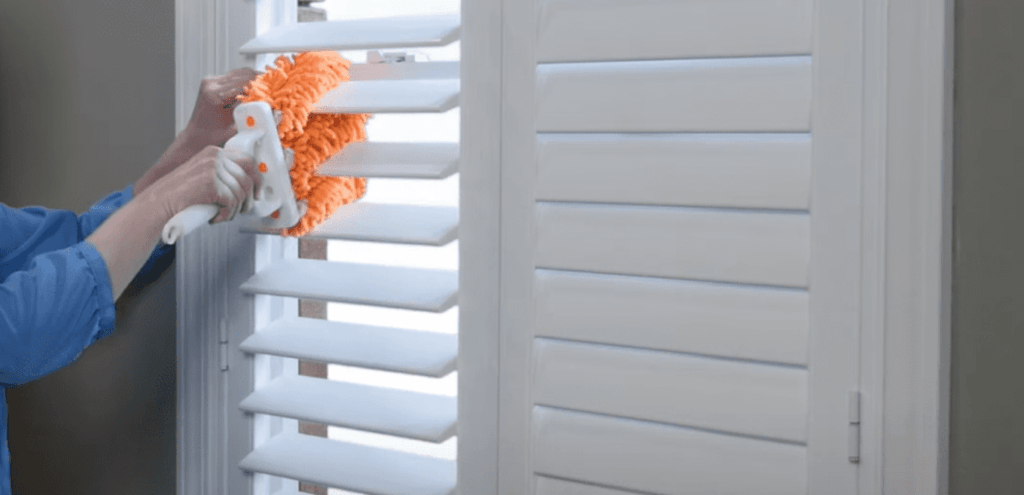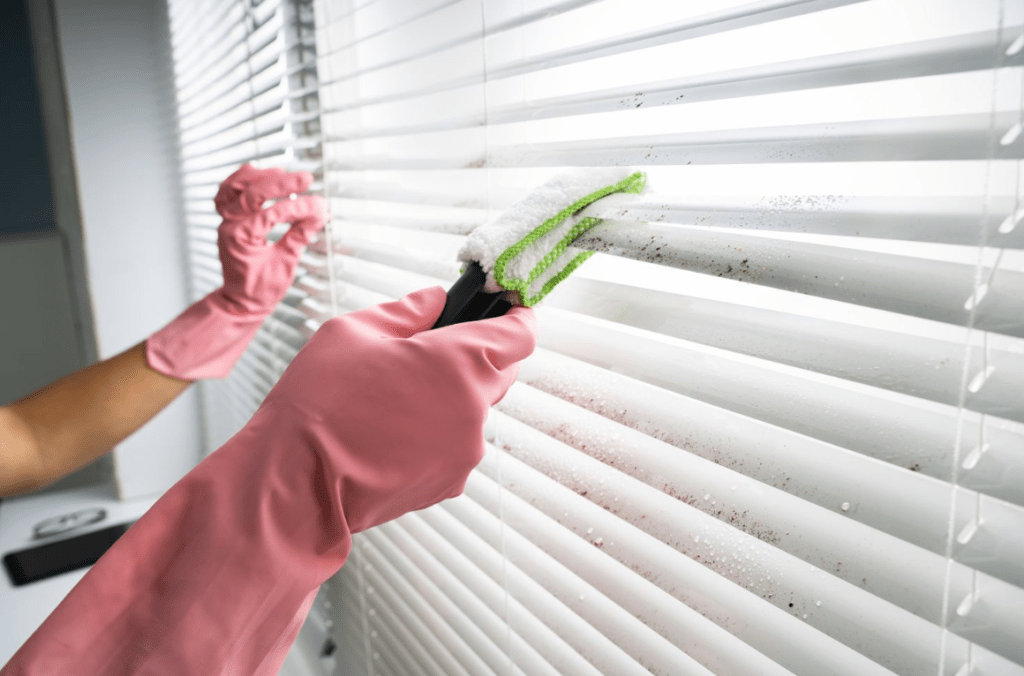Plantation shutters are a beautiful and functional addition to any home. Their timeless design and ability to control light make them a popular choice for many homeowners. However, it’s important to clean them regularly and correctly to keep them looking their best and ensure they last for many years.
In this guide, we will walk you through the steps to effectively clean both interior and exterior plantation shutters, provide tips on protecting them from the elements, and help you choose the easiest types of shutters to maintain. By following these steps, you can keep your shutters in pristine condition and enhance the overall look of your home. Read on to discover how to clean plantation shutters and keep them looking as good as new.
How to Clean Plantation Shutters

Step 1: Dust the Shutters
Use a vacuum cleaner with a brush attachment to remove loose dirt and dust particles from your plantation shutters. Regular dusting prevents dirt buildup and makes the cleaning process easier. Pay special attention to the shutter louvers and window frames, as these areas tend to accumulate the most dust.
Step 2: Wipe with a Dry Cloth
After dusting, wipe each shutter panel with a dry cloth or a microfiber cloth. This step helps in removing any remaining loose dirt. For composite shutters and vinyl shutters, a dry cloth works well. Ensure you cover all parts of the shutters, including the edges and corners, to achieve a thorough clean.
Step 3: Use a Damp Cloth for Stubborn Dirt
For more stubborn dirt, dampen a soft cloth or microfiber cloth with warm water. Wipe each shutter louver gently. Avoid using excessive water, especially on wooden shutters, as it can cause water damage. Make sure to wring out the cloth well before use to avoid dripping water onto the shutters or window frame.
Step 4: Apply Mild Dish Soap
If there are stains or stuck-on dirt, mix a few drops of mild dish soap in warm water. Use this solution with a damp cloth to clean the affected areas. Avoid using harsh chemicals or abrasive cleaners, as they can damage the shutters. Gently scrub the areas with stubborn dirt, but be careful not to scratch the surface of the shutters.
Step 5: Dry the Shutters
After cleaning, use a clean cloth to dry the shutters thoroughly. This step is crucial to prevent moisture buildup, especially in humid climates. Drying the shutters helps to maintain their appearance and prevents any potential water damage. Make sure to get into all the nooks and crannies to ensure they are completely dry.
How to Clean Exterior Plantation Shutters

Step 1: Remove Loose Dirt
Start by using a vacuum cleaner with a brush attachment or a dusting cloth to remove loose dirt from the exterior shutters. This will make the cleaning process more efficient. Exterior shutters can accumulate more dirt and debris, so it’s important to be thorough in this step.
Step 2: Rinse with Water
Using a hose or a spray bottle, rinse the shutters with water to remove any remaining loose dirt. Be gentle to avoid causing any damage. This step helps to loosen any dirt that is stuck to the shutters, making the cleaning process easier.
Step 3: Clean with Soapy Water
Mix mild dish soap with warm water in a bucket. Use a soft cloth or a sponge to clean the shutters, focusing on areas with dirt buildup or stubborn dirt. This method works well for both wooden shutters and synthetic material shutters. Be sure to scrub gently to avoid scratching the surface.
Step 4: Rinse and Dry
After cleaning, rinse the shutters thoroughly with clean water. Use a dry cloth to wipe them down and ensure no moisture remains. This step is essential to prevent water damage and maintain the shutters’ appearance. Drying the shutters also helps to prevent any mold or mildew from forming.
How to Protect Your Plantation Shutters from the Sun, Wind, and Rain
Protecting your plantation shutters from the elements is key to their longevity. For exterior shutters, consider applying a natural polish or a protective coating to shield them from sun damage and moisture. This protective layer can help to maintain the shutters’ appearance and prevent fading or warping. Regular cleaning and maintenance can also prevent dirt buildup and prolong their lifespan.
In high-humidity areas or places with frequent rain, choose moisture-resistant shutters like faux wood shutters or composite shutters. These types of shutters are less prone to warping and water damage. Additionally, during extreme weather conditions, consider closing your shutters to protect them from wind and rain. This can prevent damage and extend the life of your shutters.
Regular inspections of your shutters can help you identify any potential issues early on. Look for signs of wear and tear, such as cracks or fading, and address them promptly to keep your shutters in the best possible condition.
Which Plantation Shutters Are Easiest to Clean?
Faux wood plantation shutters and composite shutters are some of the easiest to clean. They are moisture-resistant, durable, and do not require special cleaning solutions. These shutters are designed to withstand regular cleaning and are less likely to be damaged by moisture or cleaning agents. Vinyl shutters are also a popular choice for their low maintenance. They can be easily wiped down with a damp cloth and do not require any special care.
In contrast, real wood shutters require more care and attention to prevent damage from moisture and harsh cleaning agents. While they offer a classic and elegant look, they need to be cleaned carefully to avoid water damage and maintain their appearance. For homeowners looking for easy maintenance, faux wood and vinyl shutters are the perfect choice.
Final Take
Maintaining the cleanliness and appearance of your plantation shutters is simple with these easy steps. Regular cleaning and proper protection will ensure they stay in top condition for years to come. Ready to enhance your home with beautiful custom plantation shutters? Explore the RDShades collection today and find the perfect shutters to suit your style and needs.
FAQ Section
How often should I clean my plantation shutters?
Regular cleaning is recommended every few weeks to prevent dirt buildup. The frequency of cleaning can vary depending on the environment and the amount of dust and dirt in your home. In areas with higher dust levels, more frequent cleaning may be necessary to keep your shutters looking their best.
Can I use harsh chemicals on my shutters?
No, it’s best to avoid harsh chemicals when cleaning plantation shutters. Harsh cleaners can damage the finish and material of the shutters. Instead, use mild dish soap and warm water to clean them. This gentle cleaning solution is effective in removing dirt and grime without causing damage. Always test any cleaning solution on a small, inconspicuous area before applying it to the entire shutter.
What is the best cloth for cleaning shutters?
A microfiber cloth or a soft cloth works best for cleaning shutters. These materials are gentle on the shutter surface and effective at picking up dust and dirt. Microfiber cloths are particularly good at trapping dust particles and leaving a streak-free finish. Avoid using abrasive cloths or sponges that can scratch the surface of the shutters.
How do I remove stubborn dirt from shutters?
Use a damp cloth with mild dish soap to gently clean stubborn dirt. Apply the cleaning solution to the cloth, not directly to the shutters, and gently scrub the affected areas. If the dirt is particularly stubborn, you may need to let the soapy water sit for a few minutes before wiping it away. Be sure to rinse and dry the shutters thoroughly after cleaning to prevent water damage.
What should I do if my shutters get wet?
If your shutters get wet, dry them immediately with a clean cloth to prevent water damage. Pay close attention to the edges and any areas where water may have collected. For wooden shutters, it’s especially important to dry them thoroughly to prevent warping or mold growth. If the shutters are consistently exposed to moisture, consider applying a protective coating to help shield them from water damage.
